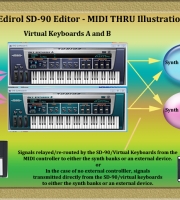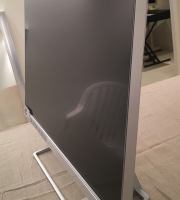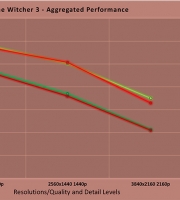


Time for some light relief me thinks. Here’s a nice fresh hot table.
Oh dear me! It is a most provoking thing when one sets an article up to analyse a piece of hardware with as much potential to influence its demographic as a sequel to caffeine, only to have another sneakily pre-empt it.
Evidently, upon seeing a towering army of ruddy cumulonimbus roll ever closer to his thriving fields, a restless and twitchy Green Giant clearly felt compelled to act, for fear a flawless cultivation may be flooded by a crimson deluge and scoured with scarlet lightening.
At the Titan X’s lavish launch, with an air of jocular cynicism , PCPer’s eminent Ryan Shrout attempted to establish a release date for the 980ti and was informed by one of the jade kingdom’s chief disciples, Tom Peterson, that a lose tongue had incurred the displeasure of his master once too often and no information would or could be divulged.
When promoting the card, he had also stated that it harnessed the Maxwell in its holiest form and doubled the spoils of its Kepler based elder without expending a single supplementary watt .
Once a ferocious flurry of Crysis crippling, Mordor mangling and forum fisticuffs had subsided, actual speed bumps resided in the region of 60 and 80% relative to the original Titan, whilst the Gk110B, which primed latter’s darker and deadlier descendant, reduced this bold assertion to hollow hype.
Nevertheless, to maintain a 250 watt TDP for its fourth crown jewel in succession and deliver such a notable gain to frenzied frame fiends was an admirable accomplishment, especially in the growing heat of AMD’s apparent willingness to forsake the rainforests if it meant a virtual forest could be rendered three seconds faster.
No clearer evidence exists of Nvidia’s assiduous eco awareness than the quantitative discrepancy in components between the Titan X and AMD’s two year old R9 290x and the current necessary to ignite their talents. The GM200 bore 256 extra stream processors 16 further texture units, 32 more Rops and almost 2 billion additional transistors but was able to deploy these and all the rest within an thermal envelope 40 watts lower than the Hawaii and elevate performance by 40%.
In the 980 ti, users of either the 780 and 780ti were presented with an enticing upgrade at a broadly agreeable bounty. Even owners of a vanilla 980, whose cravings could never be satisfied if not for that chocolate flake, would have likely nurtured no grudges in cutting their losses on auction sites and re-investing to procure healthy injection of pace. However, for those who’d already sweet-talked their spouses, forgone vacations, blown tuition fees or sold kidneys to acquire a Maxwell Rich Blend, this cost effective remedy left a sour taste in the gullet.
The inaugural Titan verged on being a concept card, thrust before a crowd of wealthy enthusiasts with intent to seize the singles crown from the HD 7970 and seduce folding smitten content creators with higher quality engineering, vast VRAM reserves, the significant advantage of double precision units and an aura of illustrious exclusivity previously reserved for Nvidia’s elite business class products.
When its trimmed down tuned up siblings materialised to bestow first person fetishists with a financially viable alternative to the r9 290x, Titan adopters could nurse their bitterness with the comforting knowledge that peerless floating point fortitude remained their unique privilege.
The 780ti had played host to an unrestrained Kepler, whose 15 streaming multiprocessors harboured a euphoric chorus of 2886 Cuda cores clocked at a scintillating 920mhz, a greater number and a higher frequency than its founding father but no double precision acceleration and half the memory. As once might guess, this translated to loftier frame rates and inferior mathematical aplomb.
The Titan X however, represented the definitive realisation of Mammoth Maxwell. No further cores could be accommodated and oscillations had reached their peak. A “Titan X Black” would remain a fantasy unless glowering Greeneyes discovered a way to “magically improve the clocks”, he didn’t. Hence, the 980ti was bound to these maximums and couldn’t transcend the abilities of its elder in any respect.
In keeping with tradition, its Ram was halved from 12 gigs to 6 and most importantly, where the 780ti had included a full complement of 15 SMXs to the Titan’s 14, the 980ti was artificially shorn of a pair, reducing its quota from 24 to 22. With all this considered, was their any logical reason to argue that Nvidia’s approach failed to demonstrate a consistent and canny assessment of its customer-base? If the Titan had managed to amicably co-exist alongside a slighter and more reasonable derivative, why couldn’t the Titan X make peace with its own? There were two reasons and the first concerns timing less sensitive than death metal at a nun’s funeral.
If we discount the ready-salted 780, which the Titan’s numerical and pictorial prowess surpassed, a period of eight months elapsed before the emergence of a cheaper top tier card offering equal or enhanced performance.

By contrast, in turning the 980ti loose less than two months after what was touted as the ultimate answer to a deep learner’s prayers as well as those of every Steamer from Middle Earth to South Vvardenfell, a routinely meticulous fleet commander could be said to have torpedoed his own flagship, despite holding true to his statements and dutifully adhering to prior form.
Additionally, in electing at the outset to eliminate the “Doppler effect” on the GM200 in order to maximise die space and augment single precision agility, Nvidia had arguably discarded far more marketable commodity to the compute-concious than either extra memory or additional standard cores.
Perhaps worst of all, the 980ti’s physical deficits had been predicted to convert to a handicap of roughly 8%, though once review samples had been shredded by their clinical and brutal interrogators, this already meagre figure was swiftly revised to 3%, and for a card over 35% less taxing on the wallet.
To put this into novel and amusing and perspective, if opting for a Titan X over its skinnier side kick, the buyer would pay approximately 50 cents for every “xtreme” 3d Mark gained, 70 dollars per frame gained at 1440p and 115 dollars for each frame gained at ultra HD, a going rate to rival that of the Louvre Museum.
But what of the future? In a world where eye candy was sweeter than saccharine and more enchanting than Violets dancing to Verdi, would’t a 12 gig buffer become imperative once anti aliasing made edges look smoother than a Harley street patient and 4k was defined as yesterday’s resolution? Unlikely. As things stood on the recreational front, 4 gigs was ideal, 6 gigs was a luxury and once games were coded to exploit 12 gigs, this X rated Titan’s Achilles would not be its memory but rather, but King Maxwell himself!